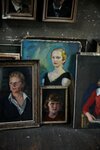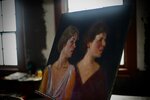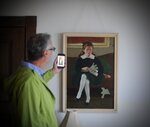




Matt Genta is holding his finger to his mouth, a sign that he is considering something. The something he is currently considering is a life-size portrait of a young girl with a green cloak. She is holding a yellow scarf and looks uncertain. The painting is propped against a wall of the Manchester Historical Museum in such a way that you know it has not yet found a home.
Matt Genta, the President of the Manchester Historical Museum, has invited me to stop by to see this new painting, discuss recent acquisitions, and take a look around. However, beyond all the lovely items here and there (the museum is currently undergoing renovation and therefore is in a delightful disarray) what has my attention is Matt’s excitement over this new painting. As we discuss the journey of the painting, how he found it, and what it might mean, I feel as though, at some point, he may push a flashlight into my hand for some adventure involving secret rooms, hidden art, and long-forgotten treasures; it’s a little Nancy Drew. But today, the girl with the green cloak is not hidden; she is here and Matt is trying to figure out exactly who she is.
Her journey began here in Manchester, at a small house on the ocean. The Hopkinson House is in and of itself a work of art. An unassuming little gem sitting near and in the shadow of the larger Stone House that most in Manchester know as the grand dame of the Sharksmouth Estate. The home was a gift from Civil War General Greely Stevenson Curtis and his wife, Harriot Appleton to their daughter, Elinor Curtis. Greely and Harriot built the summer estate at Sharksmouth around 1868 and here they raised their ten children - five sons and five daughters. Only one of the daughters would marry (the other four famously did not, and their vibrant and fascinating lives are the subject of the book The Aunts by Isabella Halsted, which I highly recommend). Elinor Curtis, the second oldest daughter, did marry and, in doing so, was given this most wonderful home. It was here where her husband would paint some of his most famous works, where they would raise their five daughters, and where the girl in the green cloak stood — here at the home of Charles Hopkinson.
Born in 1869 in Cambridge, Charles Hopkinson was a renowned artist, a portraitist and landscape watercolorist and Manchester’s most famous local artist. As a boy he attended the Hopkinson Preparatory School founded by his father where by the age of 10 he began displaying an interest in capturing movement and form through his drawings. After graduating from Harvard, he went on to study at the Arts Students League of New York and the Académie Julien in Paris. He returned to Massachusetts in early 1900, rented a studio in Beacon Hill and began publicly showing his work. Hopkinson would go on to become a highly accomplished portraitist with commissions to paint Mr. and Mrs. John D. Rockefeller, the Supreme Court Justice Oliver Wendell Holmes, President Calvin Coolidge, and other such “big game” as Hopkinson called them. He was one of a small group of select artists invited to paint the victorious allied leaders at the Versailles Peace Conference in 1919. By the time of his death in 1962 it is estimated that Hopkinson painted nearly 1,000 commissions.
But this was just one side of Charles Hopkinson, and indeed it paid the bills, but there was another side, that of daring watercolors and intimate portraits of his daughters, his wife, and their life — all of which came from his time at his beloved home in Manchester.
And it is here where the journey of the girl in the green cloak begins, for a second time. The Hopkinson House had been offered to the Historical Museum as a venue for the kick-off event for the Bicentennial year of the Abby Hooper Trask House, headquarters of the museum. The evening would focus on Winslow Homer and his connection to Manchester, which included his friendship with Hopkinson. This started Matt Genta thinking. At the time the museum had only two small watercolors by Hopkinson. Curiosity led to luck and Matt discovered that three Hopkinson paintings were being offered at auction in the coming months; Matt won all three. Two of the paintings were watercolors and one an oil portrait of Hopkinson’s daughter Joan. One of the watercolors titled “view from the terrace” was painted, as so many were, from the stunning vantage point of the house.
It is here, on the terrace, where Matt and I sat with Charlie Shurcliff, Hopkinson’s grandson and an artist himself, who told us more about his grandfather as a painter and as a person.
Listening to Charlie, you feel as though, if you just stared at him long enough, you might be able to see Hopkinson himself. The resemblance is there in both his physical presence and his work as an artist. When speaking of his grandfather, Charlie’s enormous admiration and adoration are clear. When asked about his grandfather as a man, as a person, Charlie recounts how when his mother would read to him and his brother in the evening, his grandfather, seated nearby, would pull his small pocket sketchpad and pencil from his breast pocket (which also had a jackknife for sharpening) and lovingly sketch them.
Matt’s intrigue with Hopkinson grew. Not long after the Bicentennial event, where the newly acquired Hopkinsons were revealed, Matt discovered that an estate auction of one William Trayes Jr. would be offering a full-length portrait by Hopkinson. The work was described simply as “young girl with green cloak”. The museum was the high bidder and the painting was transported to Manchester in short order and to the museum where I met her during my visit with Matt. But once she arrived, there were many questions to be answered. Who was it? And how had she gotten so far from home? Flashlights out.
Matt, once again, contacted Charlie Shurcliff who could confirm that it was almost certainly one of his five aunts, but he was not at all sure which one; his best guess was Harriot who also went by Happy. Happy married a Canadian diplomat , Alfred Rive. One week after the portrait arrived at the museum it was visited by Happy’s son, John Rive, who was still unable to confirm its identity. John’s wife Jeannete Rive further investigated the inventory of Hokinson paintings and verified it. Happy indeed.
After solving the mystery as to which of Hopkinson’s daughters this was, the question remained — how had she ended up at an estate sale? As it turns out, this is a painting that was determined to return home. It resided, rolled up, in the attic of Alfred and Happy Rive in their house in Ottawa. At some point it was given to their daughter, Hallie. She had the painting restored, stretched, framed and sold it to a gallery in Seattle (why?). Presumably the painting was sold again and this is how it ended up in the home of the Gloucester collector, William Trayes, Jr. only to be found by Matt and returned home to Manchester where it was originally painted around 1913.
I can see why she wanted to return. On our visit to Hopkinson’s home, we had the good fortune of being taken to the very top floor of the house. Hopkinson’s studio is, I say this most ardently, just as it was the day he walked out 61 years ago. Eyeglasses down, paintbrush dropped in the jar, heading downstairs to make a sandwich and then – stillness. When you are there, you feel as though he might actually return. Canvases line every wall and are stacked in every corner, this way and that, on easels and tables, all in various stages of completion. I am taken by the sheer richness of the room; Hopkinson was a master of depth and color.
It is noteworthy that amidst all of the portraits he painted, scores are of Hopkinson himself. He painted his first self-portrait at 20 and his last at 92. Perhaps to study further, perhaps to further understand himself. This is a man who was clearly kind, loved his family, and possessed a unique empathy that enabled him to give his pieces something akin to a soul. A gift to those he painted – seeing them.
And here, at his home on the sea with his beautiful family, his work took flight, and became lively, joyful, and free. So yes, I can see how our young girl, Happy in her green cloak, wanted to come back to the place she loved and was loved. And thanks to the curious mind and keen eye of Matt Genta, she has returned.
And soon you can see her. She will be on display, along with all of the other Hopkinson works, beginning September 30th at the Manchester Historical Museum. You can also see Charlie Shurcliff if you wish, he will be opening Cape Ann Plein Air with a demonstration at the Sharksmouth Estate on Sunday, October 8 at 3:30 pm.